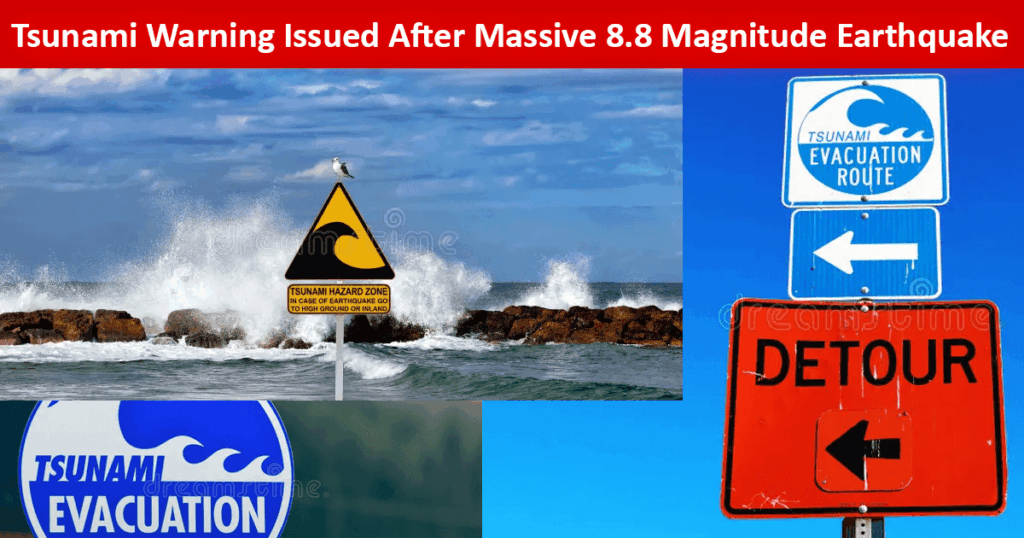📰 Tsunami Warning Issued After Massive 8.8‑Magnitude Earthquake
On July 30, 2025, a powerful magnitude‑8.8 earthquake struck just off Russia’s Kamchatka Peninsula, marking one of the most intense tremors ever recorded in the region. The seismic event triggered immediate tsunami warnings across vast stretches of the Pacific Rim—including Japan, Alaska, Hawaii, the U.S. West Coast, Canada, Taiwan, New Zealand, and several Latin American nations. Emergency alerts were activated swiftly to initiate mass evacuations and precautionary measures (AP News).
🌊 Main Event and Waves: From Russia to the Pacific
Coastal towns in Russia’s Kuril Islands—notably Severo‑Kurilsk—were struck by tsunami waves up to three meters high, causing structural damage and prompting urgent evacuations. In Japan, authorities ordered more than 900,000 residents in northern prefectures to move to higher ground as waves up to 50 cm were measured at ports such as Ishinomaki. Hawaii recorded tsunami activity of up to 4 feet, while California’s Crescent City braced for potential waves nearing 10 feet, leading officials to shut down beaches, harbours, and flight operations. Coastal advisories were issued and renewed warnings remained active across multiple zones for several hours to manage the unfolding threat (The Guardian).
⚠️ The Emergency Response & Public Instructions
Local governments mobilized evacuation procedures using sirens, mobile alerts, and public bulletins. In Hawaii, shelters opened and residents were urged to seek higher terrain immediately. Officials warned that multiple waves and hazardous currents could persist for hours, urging the public to stay clear of coastlines well beyond initial impact times. In the U.S., the alert scale ranged from watch to warning, with specific guidance to abandon low-lying areas for safety (CBS News, Tsunami.gov, AP News, ABC, CBS News).
🔍 Aftermath & Regional Updates
Fortunately, no major casualties were reported, despite infrastructure damage in isolated areas. Japan and parts of California noted coastal flooding and displacement, but widespread collapse was avoided. Emergency teams from coastlines across the Pacific remained vigilant as aftershocks continued and forecasts projected additional wave activity. Many countries—including Mexico, Peru, Ecuador, and China—activated protocols within hours of the tremor and closely monitored seismic data for developments (The Guardian).
🧠 The Science & Growing Need for Preparedness
Experts emphasize that undersea earthquakes like this can generate tsunamis that travel rapidly but intensify near shorelines. Agencies such as the Pacific Tsunami Warning Center and the Japan Meteorological Agency have improved early-warning capabilities, using satellite data and a new generation of digital infrastructure to better predict tsunami propagation and advise evacuations quickly—even in remote ocean zones. These tools are essential—disaster modeling, especially in regions like the Cascadia Subduction Zone, now leverage real-time Bayesian inference systems driven by deep learning to simulate tsunami movement almost instantly (arxiv.org).
📌 In Summary
The July 2025 tsunami warning triggered by the massive Kamchatka quake underscored the raw power of seismic activity in the Pacific “Ring of Fire.” While early alarms and swift evacuations possibly averted higher casualties, the event served as a stark reminder of coastal vulnerability. The unfolding response—spanning Alaska to Japan—demonstrated both progress in real-time warning systems and the sobering need for constant readiness. As wave activity continues to be monitored, global authorities reinforce that caution and community awareness remain essential in facing nature’s occasional fury.


